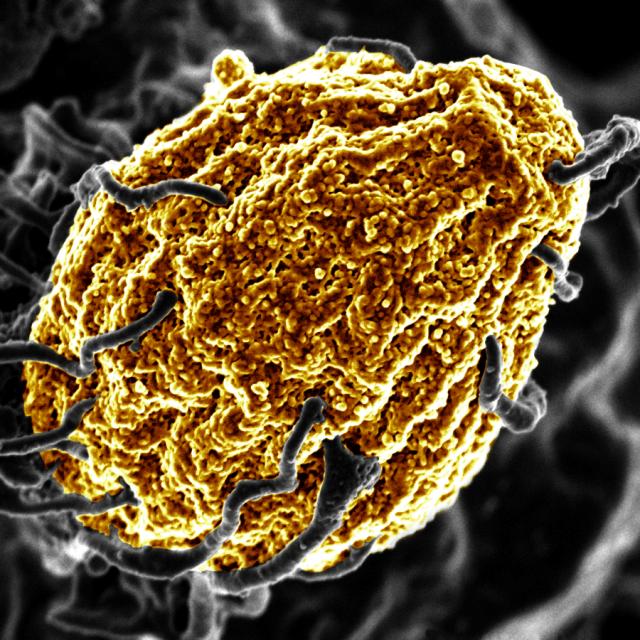Investigating The Link Between Climate Change And Aggressive Fungi

Table of Contents
Rising Temperatures and Fungal Growth
Increased global temperatures significantly impact fungal growth and survival. Higher temperatures accelerate fungal metabolic processes, leading to faster growth rates and increased reproductive output. This means that fungi can colonize new areas, expanding their habitats into regions previously unsuitable due to lower temperatures. This expansion of fungal ranges can bring them into contact with new host populations, increasing the risk of infections.
- Examples of fungi with temperature-sensitive virulence: Species like Aspergillus fumigatus, a common cause of aspergillosis, exhibit increased growth and virulence at higher temperatures. Similarly, Candida albicans, responsible for candidiasis, shows enhanced pathogenicity under warmer conditions.
- Altered fungal life cycles: Climate change can disrupt established fungal life cycles, potentially leading to more frequent and intense outbreaks of fungal diseases. Changes in temperature can affect spore production, germination, and overall fungal development.
- Temperature thresholds: Research continues to identify specific temperature thresholds for fungal growth and reproduction. Exceeding these thresholds can dramatically increase the risk of infections and outbreaks.
Increased Humidity and Fungal Spore Dispersion
Humidity plays a crucial role in fungal spore germination and dispersal. Climate change is leading to increased humidity in many regions, creating ideal conditions for fungal growth and spread. Higher humidity levels prolong spore viability, allowing them to survive longer in the environment and travel further distances. This increased humidity, coupled with altered precipitation patterns, significantly impacts fungal distribution and prevalence.
- Fungal diseases aggravated by humidity: Respiratory infections caused by fungi like Coccidioides and Histoplasma are exacerbated by increased humidity and precipitation, as spores are more readily dispersed in moist environments.
- Changes in precipitation patterns: More frequent and intense rainfall events, a hallmark of climate change, can create favorable conditions for fungal growth and spore dispersal, leading to localized outbreaks.
- Role of extreme weather events: Hurricanes, floods, and other extreme weather events can disrupt ecosystems, creating environments ripe for fungal proliferation and subsequent outbreaks in both human and animal populations.
Weakened Immune Systems and Increased Susceptibility
Climate change-related stressors, such as heat waves and increased air pollution, can significantly compromise both human and animal immune systems. This immune suppression makes individuals more vulnerable to opportunistic fungal infections, even those caused by fungi that are typically not highly pathogenic. The combined effect of climate change and weakened immunity creates a synergistic effect, increasing the severity and risk of fungal diseases.
- Heat stress and immune suppression: Numerous studies have demonstrated a clear correlation between heat stress and immune suppression, leaving individuals more susceptible to a range of infections, including those caused by fungi.
- Synergistic effect: The combination of climate change-induced stressors and fungal infections can lead to significantly worse outcomes than either factor alone.
- Increased morbidity and mortality: The interaction between climate change and fungal infections has the potential to lead to increased morbidity and mortality, especially in vulnerable populations like the elderly and immunocompromised.
Climate Change and the Emergence of New Fungal Pathogens
Climate change is not only exacerbating existing fungal threats but also creating conditions favorable for the emergence of new fungal pathogens. Changing environmental conditions can drive fungal adaptation and evolution, leading to the development of new strains with increased virulence or resistance to antifungal treatments. Predicting and managing these emerging threats presents significant challenges.
- Newly emerging fungal diseases: While definitive links are still under investigation, some newly emerging fungal diseases show a correlation with changing climatic conditions.
- Role of genetic mutations: Fungi possess remarkable adaptive capabilities, and genetic mutations driven by environmental pressures can lead to the evolution of new traits, including increased virulence or resistance to antifungal drugs.
- Challenges in predicting and managing emerging threats: The rapid pace of climate change coupled with the complex evolutionary dynamics of fungi makes predicting and managing emerging fungal threats a significant global health challenge.
Conclusion: Understanding the Complex Relationship Between Climate Change and Aggressive Fungi
The evidence strongly suggests a significant link between climate change and the increased prevalence and virulence of fungal pathogens. Rising temperatures, increased humidity, and compromised immune systems are all contributing factors to this alarming trend. Further research is crucial to fully understand the complex interactions between climate change, fungal pathogens, and human/animal health. We need more comprehensive studies to better predict and mitigate the risks posed by aggressive fungi in a changing climate. Learn more about the effects of Climate Change and Aggressive Fungi and take action today!

Featured Posts
-
 How To Make Housing Affordable Without Crashing Home Prices Insights From Gregor Robertson
May 26, 2025
How To Make Housing Affordable Without Crashing Home Prices Insights From Gregor Robertson
May 26, 2025 -
 From Plaza To Pavement The Story Of Black Lives Matter Plaza
May 26, 2025
From Plaza To Pavement The Story Of Black Lives Matter Plaza
May 26, 2025 -
 Strong Retail Sales Data Impacts Bank Of Canadas Rate Decision
May 26, 2025
Strong Retail Sales Data Impacts Bank Of Canadas Rate Decision
May 26, 2025 -
 How Canada Posts Problems Benefit Rival Delivery Services
May 26, 2025
How Canada Posts Problems Benefit Rival Delivery Services
May 26, 2025 -
 Gerard Butler And The Nepo Baby Actress Their Latest Public Appearance
May 26, 2025
Gerard Butler And The Nepo Baby Actress Their Latest Public Appearance
May 26, 2025
